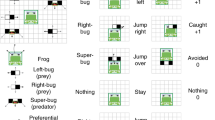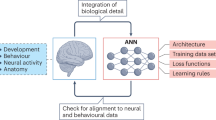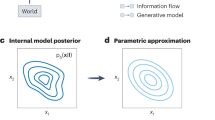Abstract
It is not only theorists who make models. All biologists work with explicit or implicit 'word models' that describe their vision of how a system works. One of the most important functions of theoretical and computational neuroscience is to translate these word models into more rigorous statements that can be checked for consistency, robustness and generalization through calculations and/or numerical simulations.
Similar content being viewed by others
Main
The process of turning a word model into a formal mathematical model invariably forces the experimentalist to confront his or her hidden assumptions. I have often found that I have 'skipped steps' in my thinking that were only revealed when we sat down to construct a formal model. It is easy to tell 'just so stories' about cells, circuits and behavior, and discussion sections of journal articles are filled with them, but the exercise of trying to instantiate the assertions in those stories makes the missing links in all of our data and understanding pop into view.
Models offer a solution to one of the hardest problems in experimental biology: how far to generalize from the data one has collected. Neuroscientists work on an array of cells and circuits in lobsters, flies, fish, birds, rats, mice, monkeys and humans. Many of the 'mistakes' in neuroscience come from inappropriate generalizations from observations made in one system, or under a given set of conditions. Experimental work I did with Scott Hooper showed that when an oscillatory neuron was electrically coupled to a non-oscillatory cell, the two-cell network had a lower frequency than the isolated oscillator. We initially assumed that this was a general statement, but later learned from theoretical work that, depending on the properties of the oscillator, either an increase or decrease in frequency could be obtained. We had correctly understood our data, but we were unaware that the other case was possible because it did not occur in the particular system we were studying. This is at the core of the usefulness of theory for an experimentalist: it helps us know when we have found only a piece of the answer, and when we have understood the full set of possible outcomes from a given set of conditions.
Finally, theory is legitimized dreaming. We all became neuroscientists out of a deep desire to explore the mysteries of how the brain works. Most of us who do experimental work spend our days preoccupied with the myriad and mundane details that are so crucial to doing experiments and analyzing data. I came of age as a scientist believing that my career would be over if I were ever wrong. For me, participating in the development of highly speculative models was akin to learning to drive as a teenager. In both cases, I remember the thrill of the freedom of the open road (and some of the trepidation of getting lost or getting a flat tire). Speculative models suggest possibilities beyond those found in one's laboratory, and can produce just that altered outlook that can send one on a new and exciting path.
Author information
Authors and Affiliations
Rights and permissions
About this article
Cite this article
Marder, E. Models identify hidden assumptions. Nat Neurosci 3 (Suppl 11), 1198 (2000). https://doi.org/10.1038/81477
Issue Date:
DOI: https://doi.org/10.1038/81477
This article is cited by
-
Using theoretical models to analyse neural development
Nature Reviews Neuroscience (2011)
-
The western mosquitofish (Gambusia affinis affinis): a new laboratory animal resource for the study of sexual dimorphism in neural circuits
Lab Animal (2008)



